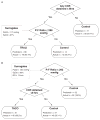Electronic health record surveillance algorithms facilitate the detection of transfusion-related pulmonary complications
- PMID: 22934792
- PMCID: PMC4839484
- DOI: 10.1111/j.1537-2995.2012.03886.x
Electronic health record surveillance algorithms facilitate the detection of transfusion-related pulmonary complications
Abstract
Background: Transfusion-related acute lung injury (TRALI) and transfusion-associated circulatory overload (TACO) are leading causes of transfusion-related mortality. Notably, poor syndrome recognition and underreporting likely result in an underestimate of their true attributable burden. We aimed to develop accurate electronic health record-based screening algorithms for improved detection of TRALI/transfused acute lung injury (ALI) and TACO.
Study design and methods: This was a retrospective observational study. The study cohort, identified from a previous National Institutes of Health-sponsored prospective investigation, included 223 transfused patients with TRALI, transfused ALI, TACO, or complication-free controls. Optimal case detection algorithms were identified using classification and regression tree (CART) analyses. Algorithm performance was evaluated with sensitivities, specificities, likelihood ratios, and overall misclassification rates.
Results: For TRALI/transfused ALI detection, CART analysis achieved a sensitivity and specificity of 83.9% (95% confidence interval [CI], 74.4%-90.4%) and 89.7% (95% CI, 80.3%-95.2%), respectively. For TACO, the sensitivity and specificity were 86.5% (95% CI, 73.6%-94.0%) and 92.3% (95% CI, 83.4%-96.8%), respectively. Reduced PaO2 /FiO2 ratios and the acquisition of posttransfusion chest radiographs were the primary determinants of case versus control status for both syndromes. Of true-positive cases identified using the screening algorithms (TRALI/transfused ALI, n = 78; TACO, n = 45), only 11 (14.1%) and five (11.1%) were reported to the blood bank by physicians, respectively.
Conclusions: Electronic screening algorithms have shown good sensitivity and specificity for identifying patients with TRALI/transfused ALI and TACO at our institution. This supports the notion that active electronic surveillance may improve case identification, thereby providing a more accurate understanding of TRALI/transfused ALI and TACO epidemiology.
© 2012 American Association of Blood Banks.
Conflict of interest statement
The authors declare that they have no conflicts of interest relevant to the manuscript submitted to
Figures



Comment in
-
Transfusion medicine data as product.Transfusion. 2013 Jun;53(6):1153-6. doi: 10.1111/trf.12226. Transfusion. 2013. PMID: 23750929 No abstract available.
References
-
- SHOT UK. Serious Hazards of Transfusion Annual Report 2010 Summary (monograph on the internet) 2010 [cited 2012 May 23]. Available from: http://www.shotuk.org/wp-content/uploads/2011/07/SHOT-2010-Summary1.pdf.
-
- FDA. Fatalities Reported to FDA Following Blood Collection and Transfusion (monograph on the internet) 2010 [cited 2012 May 23]. Available from: URL: http://www.fda.gov/downloads/BiologicsBloodVaccines/SafetyAvailability/R....
-
- Kleinman S, Caulfield T, Chan P, Davenport R, McFarland J, McPhedran S, Meade M, Morrison D, Pinsent T, Robillard P, Slinger P. Toward an understanding of transfusion-related acute lung injury: statement of a consensus panel. Transfusion. 2004;44:1774–89. - PubMed
-
- National healthcare safety network manual—biovigilance component protocol. Altanta, GA: Center for Disease Control; 2010.
-
- Toy P, Gajic O, Bacchetti P, Looney MR, Gropper MA, Hubmayr R, Lowell CA, Norris PJ, Murphy EL, Weiskopf RB, Wilson G, Koenigsberg M, Lee D, Schuller R, Wu P, Grimes B, Gandhi MJ, Winters JL, Mair D, Hirschler N, Sanchez Rosen R, Matthay MA. Transfusion related acute lung injury: incidence and risk factors. Blood. 2012;119:1757–67. - PMC - PubMed

